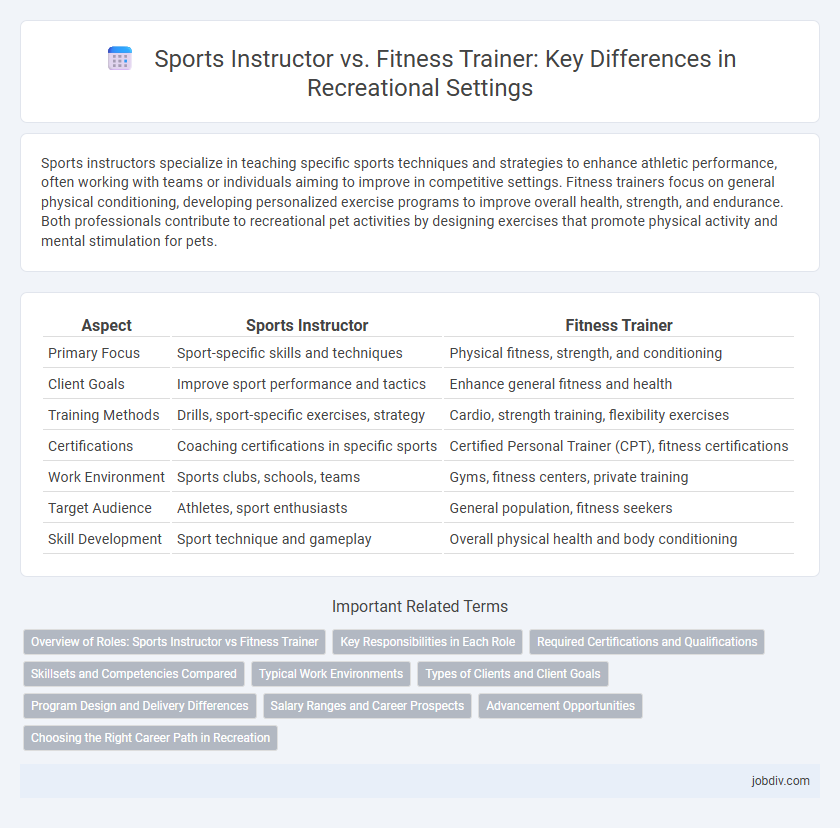Sports instructors specialize in teaching specific sports techniques and strategies to enhance athletic performance, often working with teams or individuals aiming to improve in competitive settings. Fitness trainers focus on general physical conditioning, developing personalized exercise programs to improve overall health, strength, and endurance. Both professionals contribute to recreational pet activities by designing exercises that promote physical activity and mental stimulation for pets.
Table of Comparison
| Aspect | Sports Instructor | Fitness Trainer |
|---|---|---|
| Primary Focus | Sport-specific skills and techniques | Physical fitness, strength, and conditioning |
| Client Goals | Improve sport performance and tactics | Enhance general fitness and health |
| Training Methods | Drills, sport-specific exercises, strategy | Cardio, strength training, flexibility exercises |
| Certifications | Coaching certifications in specific sports | Certified Personal Trainer (CPT), fitness certifications |
| Work Environment | Sports clubs, schools, teams | Gyms, fitness centers, private training |
| Target Audience | Athletes, sport enthusiasts | General population, fitness seekers |
| Skill Development | Sport technique and gameplay | Overall physical health and body conditioning |
Overview of Roles: Sports Instructor vs Fitness Trainer
Sports instructors specialize in teaching specific athletic skills and techniques tailored to various sports, emphasizing performance improvement and sport-specific training. Fitness trainers focus on designing personalized workout plans aimed at enhancing overall health, strength, endurance, and body composition for clients of all fitness levels. Both roles require knowledge of anatomy and exercise science but differ in their primary objectives, with sports instructors targeting competitive skill development and fitness trainers promoting general physical wellness.
Key Responsibilities in Each Role
Sports instructors specialize in teaching sport-specific skills, training techniques, and game strategies to athletes of all levels, focusing on performance improvement and competitive readiness. Fitness trainers design personalized exercise programs aimed at overall health, strength, cardiovascular fitness, and weight management, often providing guidance on proper form and motivation. Key responsibilities for sports instructors include skill development, tactical coaching, and injury prevention, while fitness trainers emphasize fitness assessments, workout plan creation, and lifestyle advice.
Required Certifications and Qualifications
Sports instructors typically require certifications such as Certified Strength and Conditioning Specialist (CSCS) or sport-specific coaching licenses, emphasizing expertise in athletic performance and skill development. Fitness trainers often hold credentials like the Certified Personal Trainer (CPT) from organizations such as ACE or NASM, focusing on general fitness, exercise programming, and client health assessments. Both roles demand CPR/AED certification, but sports instructors usually need advanced education in kinesiology or sports science, while fitness trainers prioritize practical experience in diverse fitness modalities.
Skillsets and Competencies Compared
Sports instructors possess expertise in teaching specific athletic techniques, game strategies, and sport-specific skills, emphasizing performance enhancement and injury prevention. Fitness trainers specialize in designing personalized workout plans, understanding anatomy, nutrition, and motivational coaching to improve overall physical health and endurance. Both roles require strong communication skills, but sports instructors focus more on tactical knowledge while fitness trainers prioritize holistic wellness and functional fitness competencies.
Typical Work Environments
Sports instructors typically work in specialized environments such as sports clubs, athletic facilities, and outdoor fields where they provide training tailored to specific sports disciplines. Fitness trainers are often found in gyms, wellness centers, and corporate fitness programs, focusing on general physical conditioning and individualized workout plans. Both roles may also operate in community centers or private homes, adapting their environment to client needs.
Types of Clients and Client Goals
Sports instructors primarily work with athletes aiming to improve sport-specific skills, enhance performance, and prevent injuries through targeted training. Fitness trainers typically serve a broader clientele focused on general health, weight loss, muscle building, and overall physical wellness. Client goals for sports instructors often involve competitive success and skill refinement, while fitness trainers address lifestyle changes and personalized fitness objectives.
Program Design and Delivery Differences
Sports instructors specialize in designing and delivering programs that enhance specific athletic skills and performance, using sport-specific drills and techniques tailored to individual or team goals. Fitness trainers focus on creating general physical conditioning plans aimed at improving overall health, strength, endurance, and flexibility through exercises like cardio, weight training, and functional movements. These distinct approaches ensure that sports instructors target skill development for competitive performance, while fitness trainers promote holistic fitness and wellness.
Salary Ranges and Career Prospects
Sports instructors typically earn between $35,000 and $60,000 annually, with opportunities to increase their salary through certifications and specialized training in specific sports. Fitness trainers have a broader range of salary potential, from $30,000 to $75,000, often rising with experience in personal training, group fitness, or niche markets like yoga and Pilates. Career prospects for both roles are strong, driven by growing public interest in health and wellness, but fitness trainers often benefit from more diverse job opportunities in gyms, studios, and corporate wellness programs.
Advancement Opportunities
Sports instructors can advance by becoming specialized coaches, team managers, or sports program directors, often requiring certifications in specific sports or advanced degrees in sports science. Fitness trainers may progress to roles such as wellness coordinators, personal training specialists, or fitness center managers, with opportunities enhanced by credentials in nutrition, exercise physiology, or personal training certification. Both careers offer growth through continuous education and gaining expertise in emerging fitness technologies or sports methodologies.
Choosing the Right Career Path in Recreation
Sports instructors specialize in teaching specific sports techniques and strategies, often working with teams or individual athletes to improve competitive skills and performance. Fitness trainers focus on developing personalized workout plans, enhancing overall physical health, and motivating clients to achieve fitness goals through strength, endurance, and flexibility exercises. Choosing the right career path depends on your passion for sport-specific coaching versus general fitness guidance, along with the environment and client needs you prefer in the recreation industry.
Sports Instructor vs Fitness Trainer Infographic

 jobdiv.com
jobdiv.com